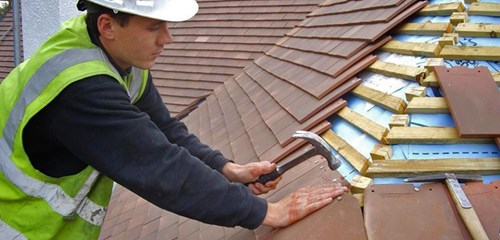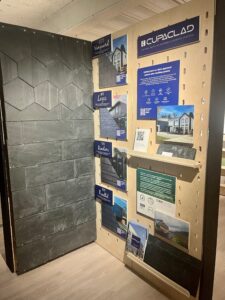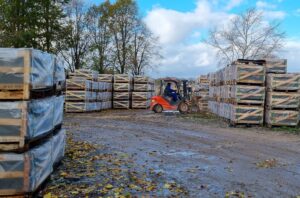Builders and roofers are sometimes called back to sort problems with dry-fix systems, even though they have been correctly installed. The new BS 8612 standard should prevent that from happening, says Graham Copson, Technical Manager of Klober.

Fixing dry-fixed. An overview of the new BS 8612 dry-fixed ridge, hip and verge product specification.
Builders and roofers are sometimes called back to sort problems with dry-fix systems, even though they have been correctly installed. The new BS 8612 Dry-fixed Ridge, Hip and Verge product specification should prevent that from happening, says Graham Copson, Technical Manager of Klober.
When residents of a new estate found that their brand-new houses were suffering from black staining down the gable end walls, everyone assumed that the roofing contractor had got it wrong. But after the roof verges were re-fitted by the manufacturer and the problem persisted, it became clear that this was not the case.
The design of the roof verges meant that they were directing rainwater down the face of the wall, rather than away from it, causing the black staining. This can also happen if the verges haven’t been fitted correctly.
This isn’t an isolated incident and it isn’t a problem that is limited to one manufacturer’s product. It only manifests itself on certain developments, depending on the aspect of the plots and the local weather conditions; and only to plain tiled roofs, as profiled tiles themselves steer rainwater away from the verge.
The new BS 8612: Dry-fixed Ridge, Hip and Verge Systems for Slating and Tiling, which was published at the end of January, aims to solve this, and other problems. It sets down rules for the testing, quality, specification and installation of dry-fixed roofing systems. At Klober, we were already aware of this problem: our current generation roof verge product prevents staining and meets the new standard.
There is a plethora of dry-fixed roofing products on the market and a widespread misperception that these are commodity products with little variation between brands – apart from cost. That just isn’t the case.
Dry-fixed products must be compatible with the tiles or slates on the roof, they must be correctly fixed and they must be properly designed. Using the wrong systems leads to roofs with problems: verges that are hanging from the edge of the roof; ridge tile and verges blown off by the wind; unsightly black staining down gable-end walls due to verges which do not shed rainwater properly.
For the housebuilder and contractor this means additional time and cost to put the problems right – and the potential for legal wrangles.
From wet to dry
Though dry-fixed products have been on the market for decades – Klober introduced its first dry verge products in 2002 – demand has burgeoned over the last five years. As a result, there’s also been a growth in the number of companies supplying lower cost, and often lower quality, products.
The switch from wet to dry was driven by changes to NHBC guidance. In 2011, NHBC analysed its claims figures for 2010 and discovered that 60% of them were related to roofs and of all roof-related claims, over half involved mortar.
As a result of its analysis, the NHBC issued new guidance in 2012 which said that all bedded ridge and hip tiles had to be mechanically fixed. The revised version of BS 5534 Slating and Tiling for Pitched Roofs and Vertical Cladding, echoed these changes. As a result, many contractors migrated to dry-fix systems as they are far faster to fit than double-fixed wet systems.
Clearly, as the number of dry-fixed roofs increases, so does the risk of problems related to dry-fixed systems. Often these problems are caused by poor installation. For instance, we hear of the wrong type of nails being used – whatever came to hand – to fix a roof verge piece or in some cases, there are no fixings at all because the roofer has wrongly assumed they are not needed.
Sometimes these problems are down to failures in the products and systems themselves. It could be that the fixing systems cannot withstand the wind loading, the adhesive on the ridge roll has not stuck adequately to the roof tiles, or the physical design of a verge causes water to run down the face of the wall.
We have seen competitor verges that have been perfectly installed but, due to their design, have caused staining after only a few years. In the worse-case scenario, if these problems are not dealt with, the wall of the property becomes damp with all the ensuing issues that can cause.
Getting it right
The new standard aims to ensure that none of the above problems occur. It talks about material properties, dimensioning, required performance and how dry-fix systems should be tested to demonstrate that they conform.
One important new requirement is testing for resistance to wind uplift forces. While BS 5534 says that dry-fix verges and ridges can be used as long as they can withstand wind uplift forces, it does not say how the products should be tested to verify this. The new BS 8612 defines tests to determine mechanical resistance to wind load and shows how specifiers should use data from these tests to verify whether a product is suitable or not, given the wind exposure of the location under consideration.
The standard also sets down a test for ridge-roll products to measure whether they can meet the profile of the roof tile at ridges and hips without breaking or splitting. A third test checks whether roof verges shed the water away from the surface of the wall, to avoid staining and damp issues. In future versions of the standard further tests will be added to test the rain resistance of ridges and hips.
The type and quality of the material is also specified, with respect to durability. Plastics must withstand UV exposure without changing colour or properties. Ridge-roll products must cope with freeze-thaw cycles and the impacts of heat and humidity.
Dry-fixed for the future
Given the fact that NHBC has been a driving force behind these changes and is represented on the committee which wrote the standard, we can expect it to mandate the use of dry-fixed systems that are compliant with BS 8612 after a period of transition. Over time, it is likely that all products will be updated so that they meet the standard.
In the meantime, it pays to check that the dry-fixed products being installed meet the standard and that they are compliant with the slates or tiles on the roof. BS 8612 says that manufacturers must provide, if requested, a product declaration of performance which includes design resistance to wind-loading and states which tiles they can be used with. They must also issue instructions – which the installer must follow!
It is important to get this right. Failures are costly and wasteful and distressing for the homeowner. Reputable manufacturers will be more-than-happy to provide technical information and advice around this subject to specifiers and installers.



